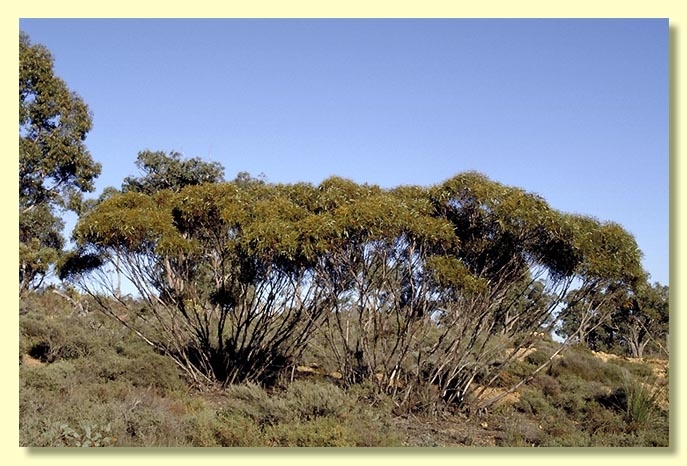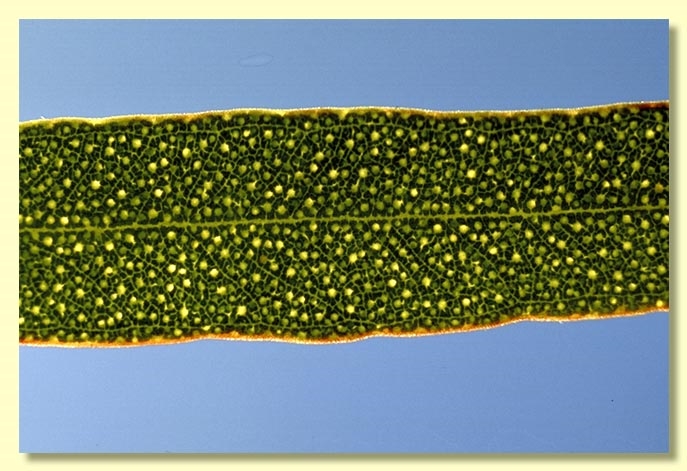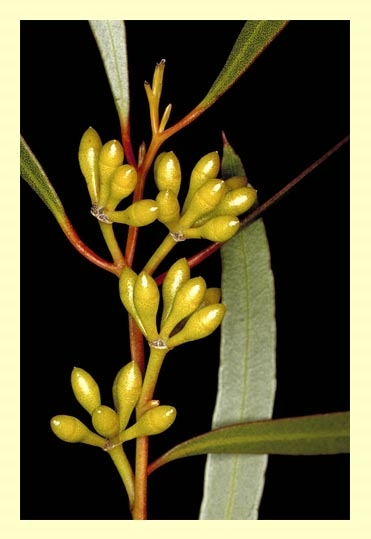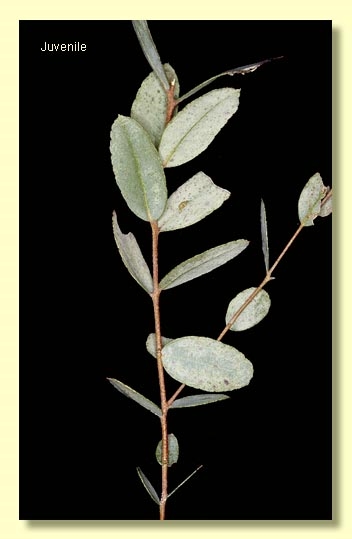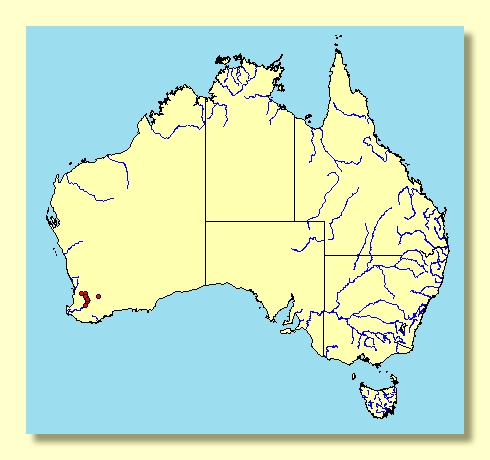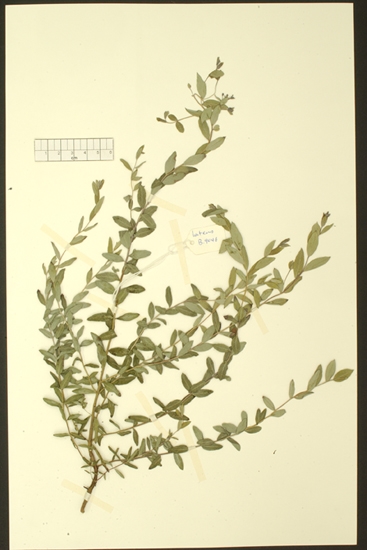Eucalyptus | Symphyomyrtus | Bisectae | Destitutae | Porantherae | Longiores
Euclid - Online edition
Eucalyptus latens
Bark smooth throughout, white to grey and coppery.
Branchlets lacking oil glands in the pith.
Juvenile growth (coppice or field seedlings to 50 cm): stems rounded in cross-section; juvenile leaves opposite and subsessile at lowest nodes, then alternate and petiolate, narrowly elliptical to oblong, 2–7 cm long, 0.5–1 cm wide, dull, bluish grey to slightly glaucous.
Adult leaves alternate, petioles 0.3–1 cm long; blade linear to narrowly lanceolate-elliptic, 4–9.5 cm long, 0.5–0.8 cm wide, base tapering to petiole, margin entire to distantly subcrenulate, apex finely pointed, concolorous, green, glossy, side-veins greater than 45° to midrib, reticulation dense, intramarginal vein present, oil glands intersectional.
Inflorescence axillary unbranched, peduncles rounded to angular, 0.4–1 cm long, buds (?7)9 or 11 per umbel, pedicellate (pedicels 0.2–0.3 cm long). Mature buds ovoid to fusiform (0.5–0.7 cm long, 0.2–0.3 cm wide), scar present, operculum conical (0.3–0.4 cm long), stamens inflexed, anthers cuneate-cuboid, adnate to filament apex (rigidly basifixed), dehiscing by sub-terminal pores, a few of the innermost stamens imperfectly formed, style long and straight or slightly twisted apically, stigma tapered, locules 3, the placentae each with 4 vertical rows of ovules. Flowers creamy white.
Fruit pedicellate (pedicels 0.1–0.3 cm long), small barrel-shaped to truncate-globose, 0.4–0.5 cm long, 0.3–0.4 cm wide, disc descending, valves 3, held near rim level.
Seeds brown to grey-brown, 1–2 mm long, flattened-ovoid, dorsal surface often with longitudinal furrows otherwise smooth, hilum ventral.
Cultivated seedlings (measured at node 10): cotyledons Y-shaped (bisected); stems rounded in cross-section, warty or smooth, often glaucous; leaves sessile to subsessile, opposite for 16 to 23+ nodes, then alternate, ovate-elliptic, 1.3–2.5 cm long, 0.5–1 cm wide, greyish green or slightly glaucous.
Flowering has been recorded in January and February.
A slender mallee endemic to Western Australia, growing on laterite in wandoo woodland in the North Bannister, Highbury, Boyagin and Kulin area. The stems are smooth and the adult leaves are glossy green.
Eucalyptus latens belongs in Eucalyptus subgenus Symphyomyrtus section Bisectae subsection Destitutae because the buds have two opercula, cotyledons are Y-shaped and branchlets lack oil glands in the pith. Within this subsection E. latens is one of a group of about 16 species, series Porantherae, that are further characterised by having anthers completely adnate to the staminal filaments, strongly inflexed stamens, densely reticulate leaves with intersectional oil glands and by the fruit with a distinct thick rim that includes a whitish descending disc. The small, glossy leaves of species in series Porantherae may result in confusion with species in series Heterostemones; however, the fruit alone usually distinguish the series. The fruit of series Heterostemones are thin-rimmed.
Its affinities are not clear but the narrow geographic range and wandoo woodland habitat combined with the smooth bark and elliptical-oblong bluish grey to glaucous juvenile leaves, distinguish it from the rough-barked coastal dune-dweller E. foecunda to the west and the wheatbelt species, E. horistes and E. albida, to the east, with their glaucous sessile orbicular juveniles leaves. Another related species occurring east from Hyden, E. olivina, differs in having subcrenulate adult leaves and linear-oblong grey-green juveniles, and seedlings that are very warty on stems and leaf-margins. Plants in the area from Narrogin to Kalgarin and Narembeen seem to be intermediate between E. latens and perhaps E. horistes or E. olivina.

